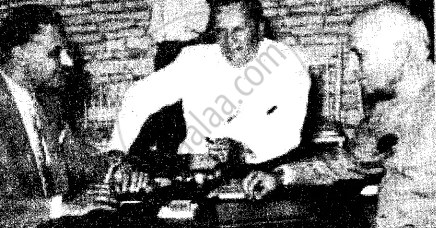Advertisements
Online Mock Tests
Chapters
2: The Executive (President and Vice-President)
3: The Prime Minister and The Council of Ministers
4: The Union Judiciary (The Supreme Court)
5: The State Judiciary (The High Court)
6: The State Judiciary (The Subordinate Courts)
7: First War of Independence: 1857
8: The Rise of Nationalism and Foundation of the Indian National Congress
9: The Programme and Achievements of the Early Nationalist
10: Rise of Assertive Nationalism
11: The Partition of Bengal
12: Formation of the Muslim League
13: The National Movement During the First World War (1915-1919)
14: Mahatma Gandhi & The National Movement (1919-1934)
15: Events Leading to the Quit India Movement (1935-1943)
16: Subhash Chandra Bose and the I.N.A
17: Towards Partition of India (1944-1947)
18: World War-I and Treaty of Versailles
19: Rise of Dictatorship and The Second World War
20: The United Nations (Origin and Purpose)
21: The United Nations Principal Organs – Composition and Functions
22: The United Nations (Major Agencies – Their Functions)
23: Universal Declaration of Human Rights
▶ 24: Non-Aligned Movement
![ICSE solutions for History and Civics [English] Class 10 ICSE chapter 24 - Non-Aligned Movement ICSE solutions for History and Civics [English] Class 10 ICSE chapter 24 - Non-Aligned Movement - Shaalaa.com](/images/history-and-civics-english-class-10-icse_6:5f2b1b2038084cf381bfa42c826a928c.jpg)
Advertisements
Solutions for Chapter 24: Non-Aligned Movement
Below listed, you can find solutions for Chapter 24 of CISCE ICSE for History and Civics [English] Class 10 ICSE.
ICSE solutions for History and Civics [English] Class 10 ICSE 24 Non-Aligned Movement Very Short Questions
Give two main features of the policy of non-alignment.
Name two architects of the NAM.
What is Panchsheel?
State the three basic objectives of the Non-Aligned Movement.
When was the first summit of NAM at Belgrade held?
How many countries attended first summit of NAM at Belgrade summit?
Mention two issues discussed at the first summit of NAM at Belgrade summit.
Who presided over this conference?
ICSE solutions for History and Civics [English] Class 10 ICSE 24 Non-Aligned Movement Short Questions I
When did the concept of non-alignment emerge? Why?
Describe briefly what is meant by non-alignment?
What led to the formation of NAM?
Non-alignment does not mean ‘isolation’ or ‘neutrality’. Why?
Mention some issues discussed at the first NAM summit.
What were Pt. Nehru’s views about non-alignment?
In what way did Nehru advocate a policy of disarmament?
How was NAM instrumental in abolishing the policy of Apartheid in South Africa?
Mention any two major problems faced by NAM.
While explaining the basic principles of non-alignment, what did Nehru propose?
What is the significance of the Bandung Conference?
ICSE solutions for History and Civics [English] Class 10 ICSE 24 Non-Aligned Movement Short Questions II
What is meant by Non-Aligned movement.
Why did Nehru advise all the newly independent Afro-Asian nations to keep themselves away from the influence of the super-powers?
State the issues discussed at Banding conference.
Mention the five principles which form the core of ‘Panchsheel’.
State two actions taken by Jawahar Lal Nehru to further strengthen the cause of Non-Alignment.
Explain how Non-Alignment is neither neutrality, nor neutralisation, nor non-commitment.
ICSE solutions for History and Civics [English] Class 10 ICSE 24 Non-Aligned Movement Long Questions
Discuss the factors that led to the formation of NAM.
What were the objectives of NAM?
Describe the role of Non-Aligned Movement in world affairs.
What is India’s role in NAM?
ICSE solutions for History and Civics [English] Class 10 ICSE 24 Non-Aligned Movement Picture Based Questions
Answer the following:
(i) Identify the persons in the picture given below.
(ii) With which movement they were associated?
Solutions for 24: Non-Aligned Movement
![ICSE solutions for History and Civics [English] Class 10 ICSE chapter 24 - Non-Aligned Movement ICSE solutions for History and Civics [English] Class 10 ICSE chapter 24 - Non-Aligned Movement - Shaalaa.com](/images/history-and-civics-english-class-10-icse_6:5f2b1b2038084cf381bfa42c826a928c.jpg)
ICSE solutions for History and Civics [English] Class 10 ICSE chapter 24 - Non-Aligned Movement
Shaalaa.com has the CISCE Mathematics History and Civics [English] Class 10 ICSE CISCE solutions in a manner that help students grasp basic concepts better and faster. The detailed, step-by-step solutions will help you understand the concepts better and clarify any confusion. ICSE solutions for Mathematics History and Civics [English] Class 10 ICSE CISCE 24 (Non-Aligned Movement) include all questions with answers and detailed explanations. This will clear students' doubts about questions and improve their application skills while preparing for board exams.
Further, we at Shaalaa.com provide such solutions so students can prepare for written exams. ICSE textbook solutions can be a core help for self-study and provide excellent self-help guidance for students.
Concepts covered in History and Civics [English] Class 10 ICSE chapter 24 Non-Aligned Movement are Meaning of Non-Aligned Movement, Panchsheel, Role of Jawaharlal Nehru, Architects of NAM, Factors Responsible for Non-Alignment, Objectives of the Non-Aligned Movement, Achievements of Non-Alignment Movement, Future of Non-Aligned Movement.
Using ICSE History and Civics [English] Class 10 ICSE solutions Non-Aligned Movement exercise by students is an easy way to prepare for the exams, as they involve solutions arranged chapter-wise and also page-wise. The questions involved in ICSE Solutions are essential questions that can be asked in the final exam. Maximum CISCE History and Civics [English] Class 10 ICSE students prefer ICSE Textbook Solutions to score more in exams.
Get the free view of Chapter 24, Non-Aligned Movement History and Civics [English] Class 10 ICSE additional questions for Mathematics History and Civics [English] Class 10 ICSE CISCE, and you can use Shaalaa.com to keep it handy for your exam preparation.
